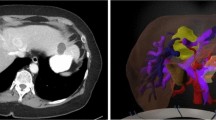Abstract
Virtual endoscopy is a term used to describe computer simulated endoscopy procedures derived from high resolution images of patient anatomy. By simulating the endoscopic examination, the patient is spared the discomfort and possible complications of an actual examination. The physician also has more flexibility in a virtual endoscopic examination of 3D patient data in comparison to a real endoscopic examination. Virtual endoscopy removes the physical and physiologic constraints of real endoscopy and can create views that are not possible in an actual endoscopic examination. This may enhance the performance of actual endoscopic examinations. Virtual endoscopy may also be used to perform “numerical biopsies”; anatomic measurements such as size, distance, shape, and density. Virtual endoscopy allows the physician to comprehensively explore the patient anatomy using an intuitive and interactive interface. There are currently two technical approaches to performing virtual endoscopy: perspective volume rendering and surface rendering of polygonal models. Perspective volume rendering uses traditional volumetric rendering algorithms to create visualizations directly from the volumetric dataset. Polygonal models require a preprocessing step to convert the segmented volume information into a polygonal surface that may be displayed at real time frame rates. Both paradigms have inherent strengths and weaknesses. We illustrate and compare the methods on actual patient data, including simulated endoscopic examinations of the airways, colon and esophagus. Preliminary results in virtual endoscopy show promise and will continue to be an area of active research leading to useful clinical applications.
Similar content being viewed by others
References
Höhne KH, Bernstein R: Shading 3D-images from CT using gray-level gradients. IEEE Transactions on Medical Imaging 5:45–47, 1986
Robb RA, Barillot C: Interactive 3-D image display and analysis. Hybrid Image and Signal Processing 939:173–202, 1988
Ning P, Bloomethal J: An evaluation of implicit surface tilers. IEEE Computer Graphics and Applications 13:33–41, 1993
National Library of Medicine (U.S.) Board of Regents. Electronic imaging: Report of the board of regents. Technical Report NIH Publication 90-2197, U.S. Department of Health and Human Services, Public Health Service, National Institutes of Health, 1990
Walsh TN, Noonan N, Hollywood D, et al: A comparison of multimodal therapy and surgery for esophageal adenocarcinoma. N Engl J Med 335:462–467, 1996
Robb RA: Surgery simulation with ANALYZE/AVW: A visualization workshop for 3-D display and analysis of multimodality medical images. Presented at Medicine Meets Virtual Reality II, San Diego, CA, February 1994
Author information
Authors and Affiliations
Rights and permissions
About this article
Cite this article
Blezek, D.J., Robb, R.A. Evaluating virtual endoscopy for clinical use. J Digit Imaging 10 (Suppl 1), 51–55 (1997). https://doi.org/10.1007/BF03168657
Issue Date:
DOI: https://doi.org/10.1007/BF03168657




